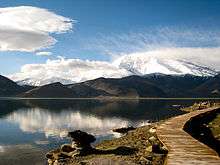Karakul (Tajikistan)
| Karakul | |
|---|---|
 | |
 Location in Tajikistan | |
| Location | Pamir Mountains |
| Coordinates | 39°1′N 73°27′E / 39.017°N 73.450°ECoordinates: 39°1′N 73°27′E / 39.017°N 73.450°E |
| Type | impact crater lake, endorheic |
| Primary outflows | none |
| Basin countries | Tajikistan |
| Max. width | 52 km (32 mi) |
| Surface area | 380 km2 (150 sq mi) |
| Max. depth | 230 m (750 ft) |
| Surface elevation | 3,900 m (12,800 ft) |
Karakul, Qarokul or Siob (Tajik for "black lake" or "black water") is a 25 km (16 mi) diameter lake[1] within a 52 km (32 mi) impact crater.[2] It is located in the Tajik National Park in the Pamir Mountains in Tajikistan.
Impact crater
Karakul lies within a circular depression interpreted as an impact crater with a rim diameter of 52 km (32 mi).[2] The crater is relatively recent: its age is estimated variously as 25 Ma,[1] less than 23 Ma,[3] or probably from the Pliocene[4] (5.3 to 2.6 Ma). The Earth Impact Database (EID) lists it as less than 5 Ma, or during the Pliocene.[2] It is larger than the Eltanin impact, which has already been suggested as a contributor to the cooling and ice cap formation in the Northern Hemisphere during the Pliocene.[5]
The Karakul impact structure was first identified through studies of imagery taken from space.
Lake description


The lake was formerly named after Queen Victoria by the British until the 1920s when it was renamed Karakul, or the Black Lake. It lies at an elevation of 3,960 m (12,990 ft) above mean sea level. A peninsula projecting from the south shore and an island off the north shore divide the lake into two basins: a smaller, relatively shallow eastern one, between 13 to 19 m (43 to 62 ft) deep, and a larger western one, 221 to 230 m (725 to 755 ft) deep. It is endorheic (lacking a drainage outlet) and the water is brackish. There is a small village with the same name on the eastern shore of the lake.[6]
Environment
Although the lake lies within a national park, much of the surroundings are used as pasture. The lake, with its islands, marshes, wet meadows, peat bogs, and pebbly and sandy plains, has been identified by BirdLife International as an Important Bird Area (IBA) because it supports significant numbers of the populations of various bird species, either as residents, or as breeding or passage migrants. These include bar-headed geese, ruddy shelducks, common mergansers, saker falcons, Himalayan vultures, lesser sand plovers, brown-headed gulls, Tibetan sandgrouse, yellow-billed choughs, white-tailed rubythroats, white-winged redstarts, white-winged snowfinches, rufous-streaked accentors, brown accentors, black-headed mountain-finches and Caucasian great rosefinches. The lake's islands are the main places where waterbirds rest and nest. The only fish in the lake is a species of stone loach.[6]
Events
Higher than Lake Titicaca, Karakul hosted the Roof of the World Regatta for the first time in September 2014. This replaced the Alpine Bank Dillon Open, held on the Dillon Reservoir in Summit County, Colorado, as the highest sailing regatta in the world.
References
- 1 2 "Kara-Kul Structure, Tajikistan". NASA Earth Observatory. Retrieved 2016-04-29.
- 1 2 3 "Kara-Kul". Earth Impact Database. University of New Brunswick. Retrieved 2009-08-15.
- ↑ Bouley, S.; Baratoux, D.; Baratoux, L.; Colas, F.; Dauvergne, J.; Losiak, A.; Vaubaillon, J.; Bourdeille, C.; Jullien, A.; Ibadinov, K. (American Geophysical Union, Fall Meeting 2011). "Karakul: a young complex impact crater in the Pamir, Tajikistan".
- ↑ Gurov, E. P., Gurova, H.P., Rakitskaya, R.B. and Yamnichenko,A.Yu. (1993). "The Karakul depression in Pamirs - the first impact structure in central Asia" (PDF). Lunar and Planetary Science XXIV, pp. 591-592.
- ↑ University of New South Wales (19 September 2012). "Did a Pacific Ocean meteor trigger the Ice Age?". Retrieved 8 October 2012.
- 1 2 "Karakul lake and mountains". Important Bird Areas factsheet. BirdLife International. 2013. Retrieved 2013-04-04.
| Wikimedia Commons has media related to Kara-Kul. |
External links
"Qarakul Lake". Information Portal Tourism in Tajikistan. Retrieved 2012-03-06.

